AT1 Case Study 2: Louise's Physiological Changes and Gymnastics
VerifiedAdded on 2023/01/24
|6
|1706
|98
Case Study
AI Summary
This case study examines the adolescent development of Louise, a 14-year-old gymnast, exploring the physiological, structural, cognitive, and social changes she is experiencing. The study analyzes the impact of high-level gymnastics on her growth and development, considering potential influences on her body, cognition, and social interactions. It also evaluates training guidelines for young athletes like Louise, emphasizing the importance of a balanced diet, adequate rest, and injury prevention strategies, including exercise categorization and recommendations for avoiding common injuries. The case study references relevant research to support its analysis and provides practical insights into supporting the health and well-being of adolescent athletes. The student also reflects on the assignment and how they met the grading rubric.
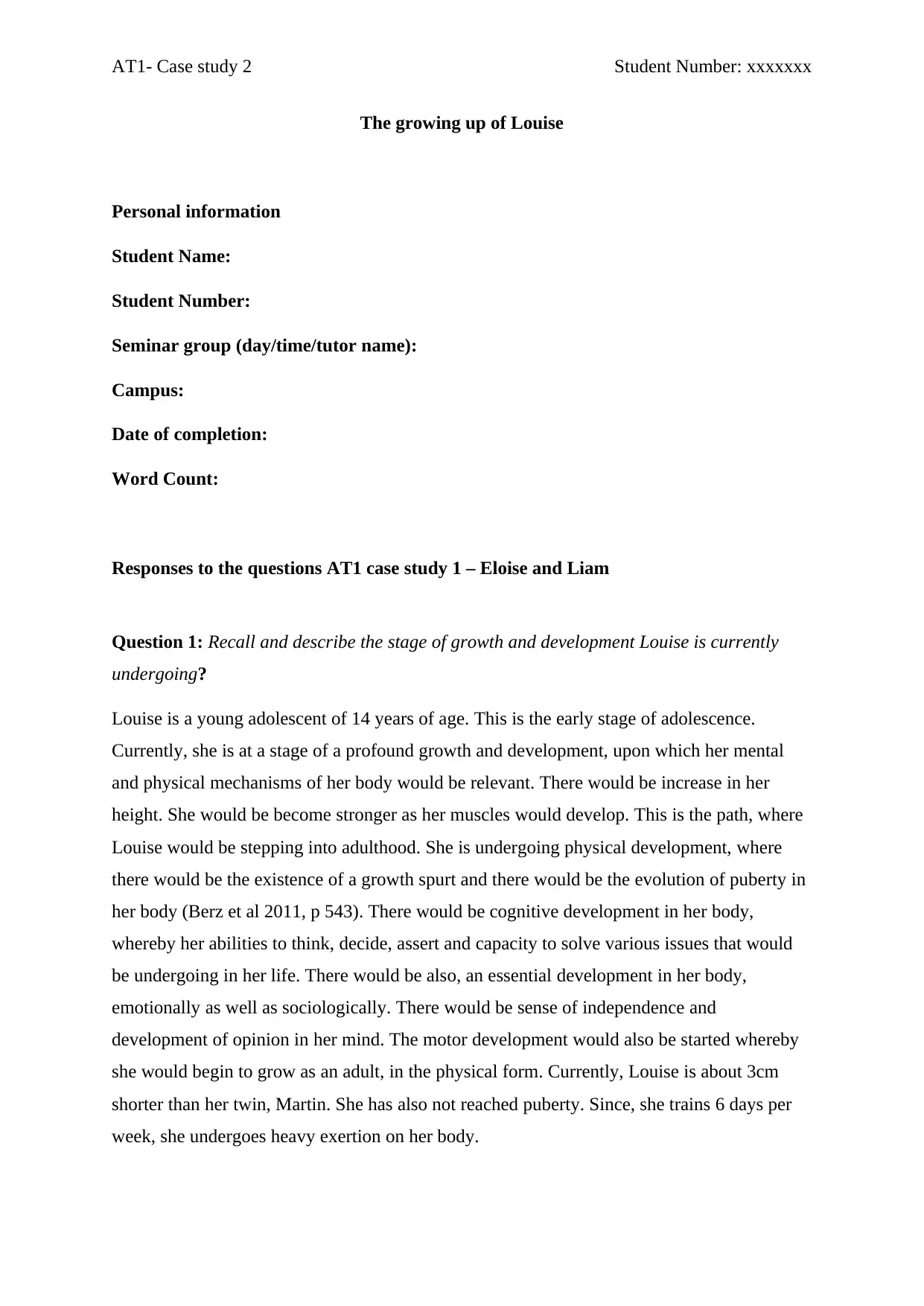
AT1- Case study 2 Student Number: xxxxxxx
The growing up of Louise
Personal information
Student Name:
Student Number:
Seminar group (day/time/tutor name):
Campus:
Date of completion:
Word Count:
Responses to the questions AT1 case study 1 – Eloise and Liam
Question 1: Recall and describe the stage of growth and development Louise is currently
undergoing?
Louise is a young adolescent of 14 years of age. This is the early stage of adolescence.
Currently, she is at a stage of a profound growth and development, upon which her mental
and physical mechanisms of her body would be relevant. There would be increase in her
height. She would be become stronger as her muscles would develop. This is the path, where
Louise would be stepping into adulthood. She is undergoing physical development, where
there would be the existence of a growth spurt and there would be the evolution of puberty in
her body (Berz et al 2011, p 543). There would be cognitive development in her body,
whereby her abilities to think, decide, assert and capacity to solve various issues that would
be undergoing in her life. There would be also, an essential development in her body,
emotionally as well as sociologically. There would be sense of independence and
development of opinion in her mind. The motor development would also be started whereby
she would begin to grow as an adult, in the physical form. Currently, Louise is about 3cm
shorter than her twin, Martin. She has also not reached puberty. Since, she trains 6 days per
week, she undergoes heavy exertion on her body.
The growing up of Louise
Personal information
Student Name:
Student Number:
Seminar group (day/time/tutor name):
Campus:
Date of completion:
Word Count:
Responses to the questions AT1 case study 1 – Eloise and Liam
Question 1: Recall and describe the stage of growth and development Louise is currently
undergoing?
Louise is a young adolescent of 14 years of age. This is the early stage of adolescence.
Currently, she is at a stage of a profound growth and development, upon which her mental
and physical mechanisms of her body would be relevant. There would be increase in her
height. She would be become stronger as her muscles would develop. This is the path, where
Louise would be stepping into adulthood. She is undergoing physical development, where
there would be the existence of a growth spurt and there would be the evolution of puberty in
her body (Berz et al 2011, p 543). There would be cognitive development in her body,
whereby her abilities to think, decide, assert and capacity to solve various issues that would
be undergoing in her life. There would be also, an essential development in her body,
emotionally as well as sociologically. There would be sense of independence and
development of opinion in her mind. The motor development would also be started whereby
she would begin to grow as an adult, in the physical form. Currently, Louise is about 3cm
shorter than her twin, Martin. She has also not reached puberty. Since, she trains 6 days per
week, she undergoes heavy exertion on her body.
Paraphrase This Document
Need a fresh take? Get an instant paraphrase of this document with our AI Paraphraser
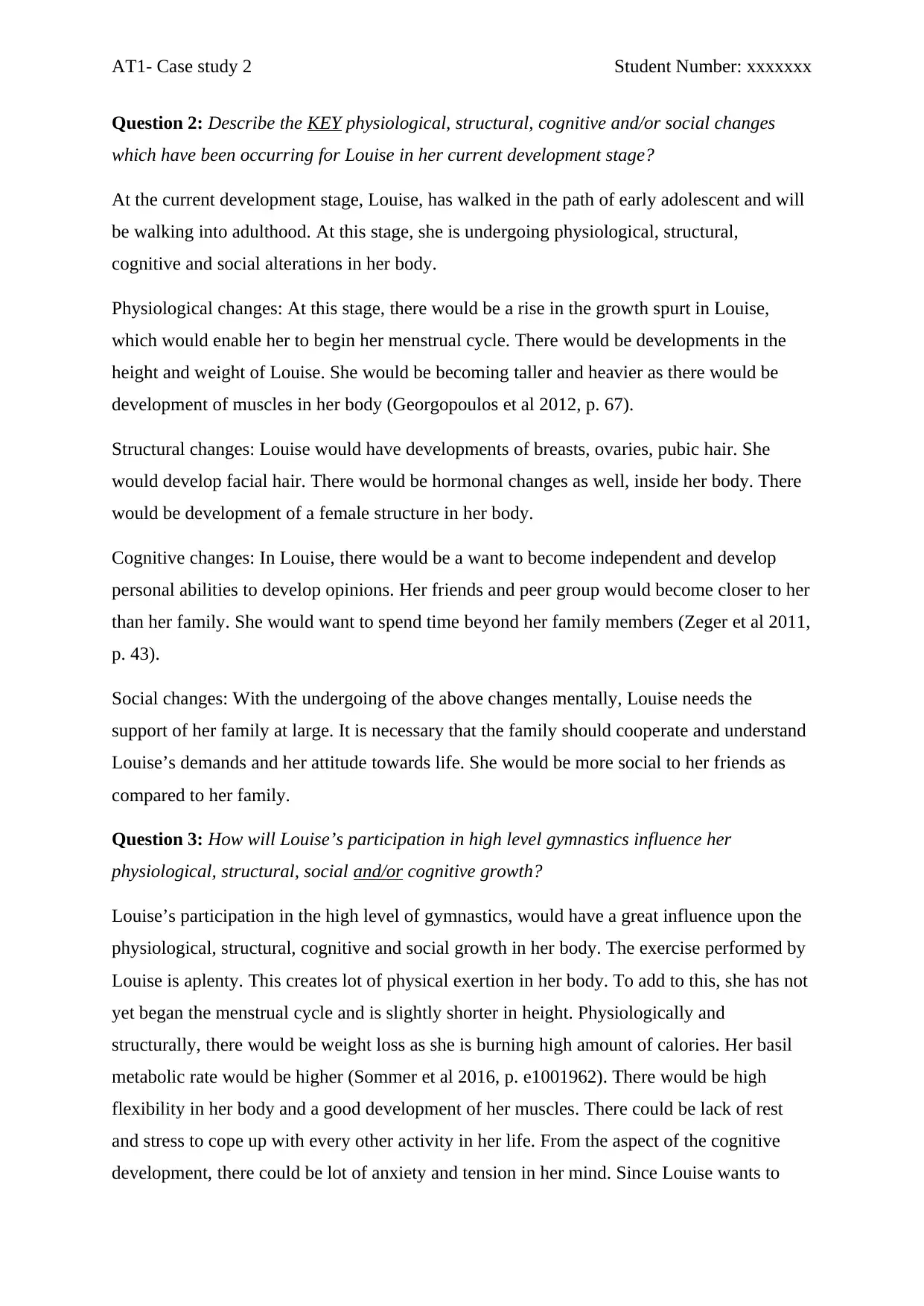
AT1- Case study 2 Student Number: xxxxxxx
Question 2: Describe the KEY physiological, structural, cognitive and/or social changes
which have been occurring for Louise in her current development stage?
At the current development stage, Louise, has walked in the path of early adolescent and will
be walking into adulthood. At this stage, she is undergoing physiological, structural,
cognitive and social alterations in her body.
Physiological changes: At this stage, there would be a rise in the growth spurt in Louise,
which would enable her to begin her menstrual cycle. There would be developments in the
height and weight of Louise. She would be becoming taller and heavier as there would be
development of muscles in her body (Georgopoulos et al 2012, p. 67).
Structural changes: Louise would have developments of breasts, ovaries, pubic hair. She
would develop facial hair. There would be hormonal changes as well, inside her body. There
would be development of a female structure in her body.
Cognitive changes: In Louise, there would be a want to become independent and develop
personal abilities to develop opinions. Her friends and peer group would become closer to her
than her family. She would want to spend time beyond her family members (Zeger et al 2011,
p. 43).
Social changes: With the undergoing of the above changes mentally, Louise needs the
support of her family at large. It is necessary that the family should cooperate and understand
Louise’s demands and her attitude towards life. She would be more social to her friends as
compared to her family.
Question 3: How will Louise’s participation in high level gymnastics influence her
physiological, structural, social and/or cognitive growth?
Louise’s participation in the high level of gymnastics, would have a great influence upon the
physiological, structural, cognitive and social growth in her body. The exercise performed by
Louise is aplenty. This creates lot of physical exertion in her body. To add to this, she has not
yet began the menstrual cycle and is slightly shorter in height. Physiologically and
structurally, there would be weight loss as she is burning high amount of calories. Her basil
metabolic rate would be higher (Sommer et al 2016, p. e1001962). There would be high
flexibility in her body and a good development of her muscles. There could be lack of rest
and stress to cope up with every other activity in her life. From the aspect of the cognitive
development, there could be lot of anxiety and tension in her mind. Since Louise wants to
Question 2: Describe the KEY physiological, structural, cognitive and/or social changes
which have been occurring for Louise in her current development stage?
At the current development stage, Louise, has walked in the path of early adolescent and will
be walking into adulthood. At this stage, she is undergoing physiological, structural,
cognitive and social alterations in her body.
Physiological changes: At this stage, there would be a rise in the growth spurt in Louise,
which would enable her to begin her menstrual cycle. There would be developments in the
height and weight of Louise. She would be becoming taller and heavier as there would be
development of muscles in her body (Georgopoulos et al 2012, p. 67).
Structural changes: Louise would have developments of breasts, ovaries, pubic hair. She
would develop facial hair. There would be hormonal changes as well, inside her body. There
would be development of a female structure in her body.
Cognitive changes: In Louise, there would be a want to become independent and develop
personal abilities to develop opinions. Her friends and peer group would become closer to her
than her family. She would want to spend time beyond her family members (Zeger et al 2011,
p. 43).
Social changes: With the undergoing of the above changes mentally, Louise needs the
support of her family at large. It is necessary that the family should cooperate and understand
Louise’s demands and her attitude towards life. She would be more social to her friends as
compared to her family.
Question 3: How will Louise’s participation in high level gymnastics influence her
physiological, structural, social and/or cognitive growth?
Louise’s participation in the high level of gymnastics, would have a great influence upon the
physiological, structural, cognitive and social growth in her body. The exercise performed by
Louise is aplenty. This creates lot of physical exertion in her body. To add to this, she has not
yet began the menstrual cycle and is slightly shorter in height. Physiologically and
structurally, there would be weight loss as she is burning high amount of calories. Her basil
metabolic rate would be higher (Sommer et al 2016, p. e1001962). There would be high
flexibility in her body and a good development of her muscles. There could be lack of rest
and stress to cope up with every other activity in her life. From the aspect of the cognitive
development, there could be lot of anxiety and tension in her mind. Since Louise wants to
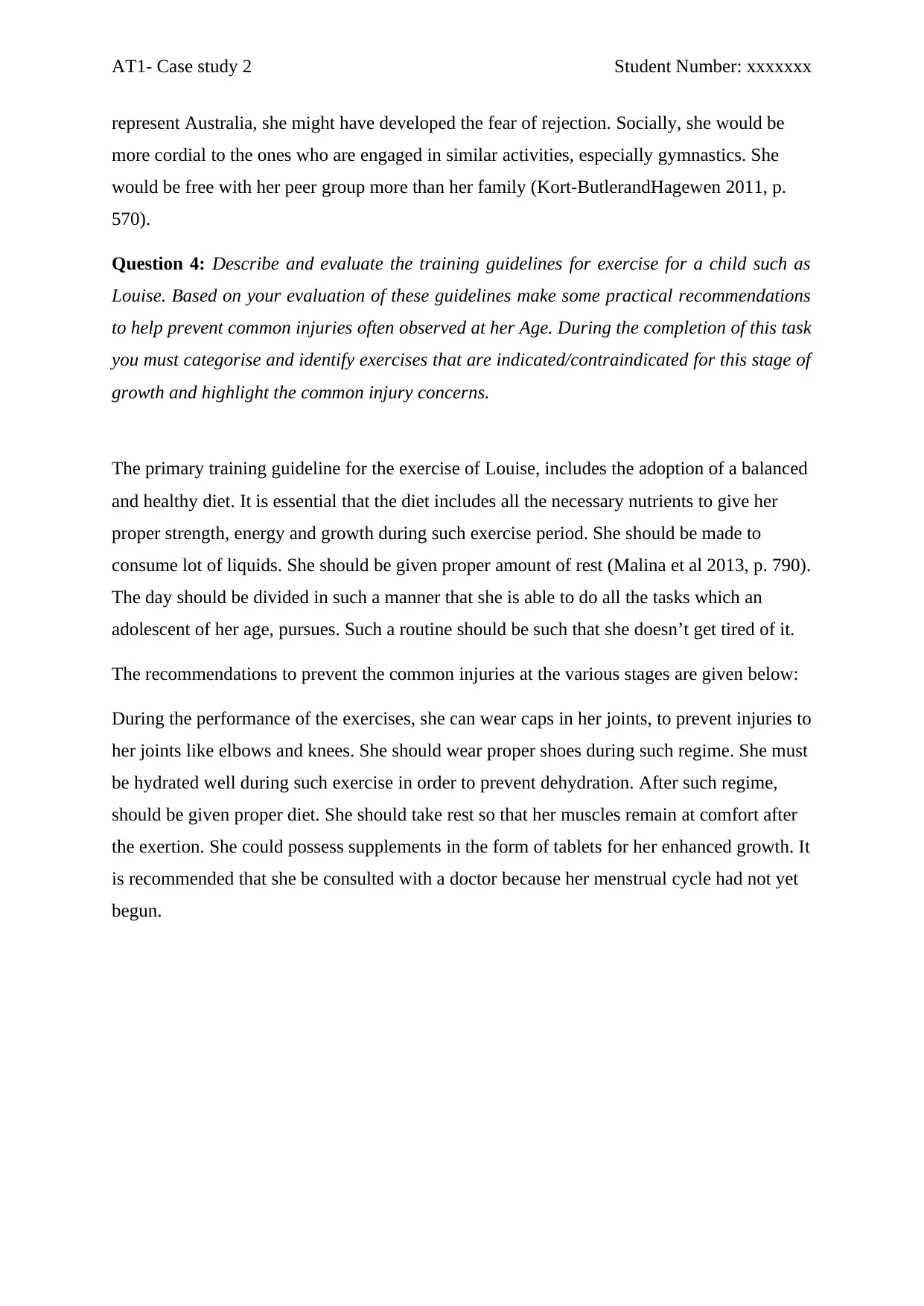
AT1- Case study 2 Student Number: xxxxxxx
represent Australia, she might have developed the fear of rejection. Socially, she would be
more cordial to the ones who are engaged in similar activities, especially gymnastics. She
would be free with her peer group more than her family (Kort-ButlerandHagewen 2011, p.
570).
Question 4: Describe and evaluate the training guidelines for exercise for a child such as
Louise. Based on your evaluation of these guidelines make some practical recommendations
to help prevent common injuries often observed at her Age. During the completion of this task
you must categorise and identify exercises that are indicated/contraindicated for this stage of
growth and highlight the common injury concerns.
The primary training guideline for the exercise of Louise, includes the adoption of a balanced
and healthy diet. It is essential that the diet includes all the necessary nutrients to give her
proper strength, energy and growth during such exercise period. She should be made to
consume lot of liquids. She should be given proper amount of rest (Malina et al 2013, p. 790).
The day should be divided in such a manner that she is able to do all the tasks which an
adolescent of her age, pursues. Such a routine should be such that she doesn’t get tired of it.
The recommendations to prevent the common injuries at the various stages are given below:
During the performance of the exercises, she can wear caps in her joints, to prevent injuries to
her joints like elbows and knees. She should wear proper shoes during such regime. She must
be hydrated well during such exercise in order to prevent dehydration. After such regime,
should be given proper diet. She should take rest so that her muscles remain at comfort after
the exertion. She could possess supplements in the form of tablets for her enhanced growth. It
is recommended that she be consulted with a doctor because her menstrual cycle had not yet
begun.
represent Australia, she might have developed the fear of rejection. Socially, she would be
more cordial to the ones who are engaged in similar activities, especially gymnastics. She
would be free with her peer group more than her family (Kort-ButlerandHagewen 2011, p.
570).
Question 4: Describe and evaluate the training guidelines for exercise for a child such as
Louise. Based on your evaluation of these guidelines make some practical recommendations
to help prevent common injuries often observed at her Age. During the completion of this task
you must categorise and identify exercises that are indicated/contraindicated for this stage of
growth and highlight the common injury concerns.
The primary training guideline for the exercise of Louise, includes the adoption of a balanced
and healthy diet. It is essential that the diet includes all the necessary nutrients to give her
proper strength, energy and growth during such exercise period. She should be made to
consume lot of liquids. She should be given proper amount of rest (Malina et al 2013, p. 790).
The day should be divided in such a manner that she is able to do all the tasks which an
adolescent of her age, pursues. Such a routine should be such that she doesn’t get tired of it.
The recommendations to prevent the common injuries at the various stages are given below:
During the performance of the exercises, she can wear caps in her joints, to prevent injuries to
her joints like elbows and knees. She should wear proper shoes during such regime. She must
be hydrated well during such exercise in order to prevent dehydration. After such regime,
should be given proper diet. She should take rest so that her muscles remain at comfort after
the exertion. She could possess supplements in the form of tablets for her enhanced growth. It
is recommended that she be consulted with a doctor because her menstrual cycle had not yet
begun.
⊘ This is a preview!⊘
Do you want full access?
Subscribe today to unlock all pages.

Trusted by 1+ million students worldwide
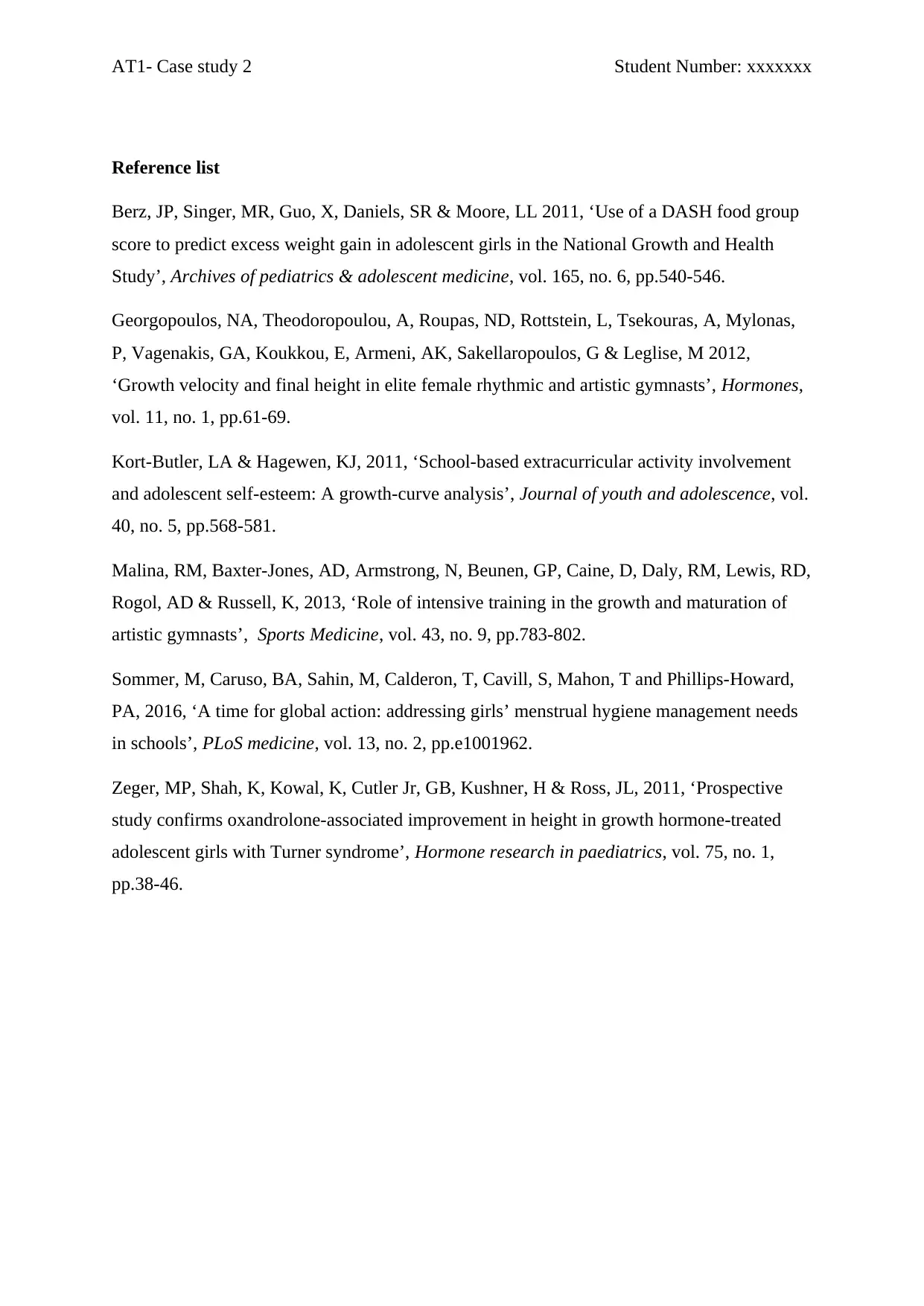
AT1- Case study 2 Student Number: xxxxxxx
Reference list
Berz, JP, Singer, MR, Guo, X, Daniels, SR & Moore, LL 2011, ‘Use of a DASH food group
score to predict excess weight gain in adolescent girls in the National Growth and Health
Study’, Archives of pediatrics & adolescent medicine, vol. 165, no. 6, pp.540-546.
Georgopoulos, NA, Theodoropoulou, A, Roupas, ND, Rottstein, L, Tsekouras, A, Mylonas,
P, Vagenakis, GA, Koukkou, E, Armeni, AK, Sakellaropoulos, G & Leglise, M 2012,
‘Growth velocity and final height in elite female rhythmic and artistic gymnasts’, Hormones,
vol. 11, no. 1, pp.61-69.
Kort-Butler, LA & Hagewen, KJ, 2011, ‘School-based extracurricular activity involvement
and adolescent self-esteem: A growth-curve analysis’, Journal of youth and adolescence, vol.
40, no. 5, pp.568-581.
Malina, RM, Baxter-Jones, AD, Armstrong, N, Beunen, GP, Caine, D, Daly, RM, Lewis, RD,
Rogol, AD & Russell, K, 2013, ‘Role of intensive training in the growth and maturation of
artistic gymnasts’, Sports Medicine, vol. 43, no. 9, pp.783-802.
Sommer, M, Caruso, BA, Sahin, M, Calderon, T, Cavill, S, Mahon, T and Phillips-Howard,
PA, 2016, ‘A time for global action: addressing girls’ menstrual hygiene management needs
in schools’, PLoS medicine, vol. 13, no. 2, pp.e1001962.
Zeger, MP, Shah, K, Kowal, K, Cutler Jr, GB, Kushner, H & Ross, JL, 2011, ‘Prospective
study confirms oxandrolone-associated improvement in height in growth hormone-treated
adolescent girls with Turner syndrome’, Hormone research in paediatrics, vol. 75, no. 1,
pp.38-46.
Reference list
Berz, JP, Singer, MR, Guo, X, Daniels, SR & Moore, LL 2011, ‘Use of a DASH food group
score to predict excess weight gain in adolescent girls in the National Growth and Health
Study’, Archives of pediatrics & adolescent medicine, vol. 165, no. 6, pp.540-546.
Georgopoulos, NA, Theodoropoulou, A, Roupas, ND, Rottstein, L, Tsekouras, A, Mylonas,
P, Vagenakis, GA, Koukkou, E, Armeni, AK, Sakellaropoulos, G & Leglise, M 2012,
‘Growth velocity and final height in elite female rhythmic and artistic gymnasts’, Hormones,
vol. 11, no. 1, pp.61-69.
Kort-Butler, LA & Hagewen, KJ, 2011, ‘School-based extracurricular activity involvement
and adolescent self-esteem: A growth-curve analysis’, Journal of youth and adolescence, vol.
40, no. 5, pp.568-581.
Malina, RM, Baxter-Jones, AD, Armstrong, N, Beunen, GP, Caine, D, Daly, RM, Lewis, RD,
Rogol, AD & Russell, K, 2013, ‘Role of intensive training in the growth and maturation of
artistic gymnasts’, Sports Medicine, vol. 43, no. 9, pp.783-802.
Sommer, M, Caruso, BA, Sahin, M, Calderon, T, Cavill, S, Mahon, T and Phillips-Howard,
PA, 2016, ‘A time for global action: addressing girls’ menstrual hygiene management needs
in schools’, PLoS medicine, vol. 13, no. 2, pp.e1001962.
Zeger, MP, Shah, K, Kowal, K, Cutler Jr, GB, Kushner, H & Ross, JL, 2011, ‘Prospective
study confirms oxandrolone-associated improvement in height in growth hormone-treated
adolescent girls with Turner syndrome’, Hormone research in paediatrics, vol. 75, no. 1,
pp.38-46.
Paraphrase This Document
Need a fresh take? Get an instant paraphrase of this document with our AI Paraphraser
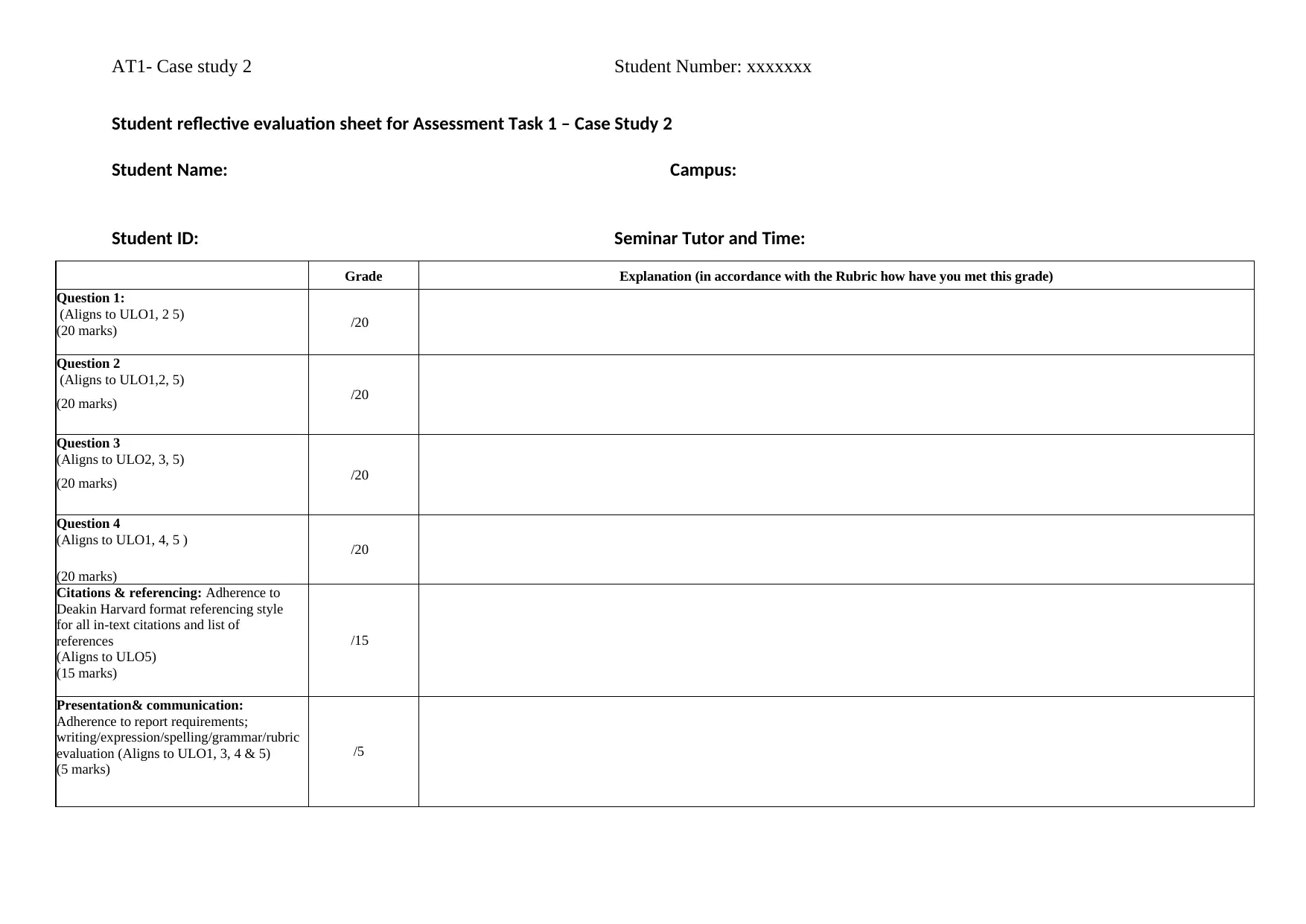
AT1- Case study 2 Student Number: xxxxxxx
Student reflective evaluation sheet for Assessment Task 1 – Case Study 2
Student Name: Campus:
Student ID: Seminar Tutor and Time:
Grade Explanation (in accordance with the Rubric how have you met this grade)
Question 1:
(Aligns to ULO1, 2 5)
(20 marks) /20
Question 2
(Aligns to ULO1,2, 5)
(20 marks) /20
Question 3
(Aligns to ULO2, 3, 5)
(20 marks) /20
Question 4
(Aligns to ULO1, 4, 5 )
(20 marks)
/20
Citations & referencing: Adherence to
Deakin Harvard format referencing style
for all in-text citations and list of
references
(Aligns to ULO5)
(15 marks)
/15
Presentation& communication:
Adherence to report requirements;
writing/expression/spelling/grammar/rubric
evaluation (Aligns to ULO1, 3, 4 & 5)
(5 marks)
/5
Student reflective evaluation sheet for Assessment Task 1 – Case Study 2
Student Name: Campus:
Student ID: Seminar Tutor and Time:
Grade Explanation (in accordance with the Rubric how have you met this grade)
Question 1:
(Aligns to ULO1, 2 5)
(20 marks) /20
Question 2
(Aligns to ULO1,2, 5)
(20 marks) /20
Question 3
(Aligns to ULO2, 3, 5)
(20 marks) /20
Question 4
(Aligns to ULO1, 4, 5 )
(20 marks)
/20
Citations & referencing: Adherence to
Deakin Harvard format referencing style
for all in-text citations and list of
references
(Aligns to ULO5)
(15 marks)
/15
Presentation& communication:
Adherence to report requirements;
writing/expression/spelling/grammar/rubric
evaluation (Aligns to ULO1, 3, 4 & 5)
(5 marks)
/5
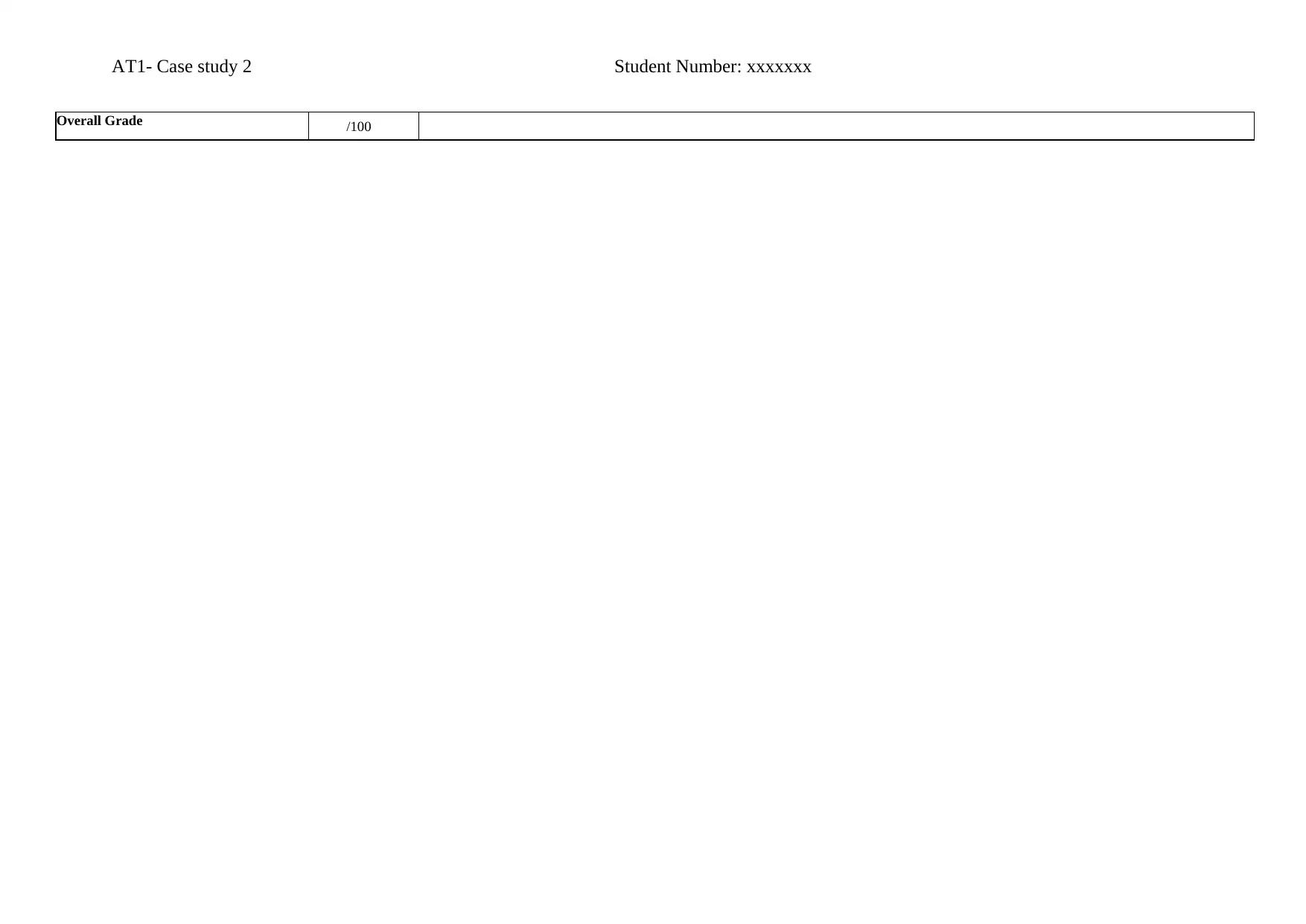
AT1- Case study 2 Student Number: xxxxxxx
Overall Grade /100
Overall Grade /100
⊘ This is a preview!⊘
Do you want full access?
Subscribe today to unlock all pages.

Trusted by 1+ million students worldwide
1 out of 6
Related Documents
Your All-in-One AI-Powered Toolkit for Academic Success.
+13062052269
info@desklib.com
Available 24*7 on WhatsApp / Email
![[object Object]](/_next/static/media/star-bottom.7253800d.svg)
Unlock your academic potential
Copyright © 2020–2025 A2Z Services. All Rights Reserved. Developed and managed by ZUCOL.




